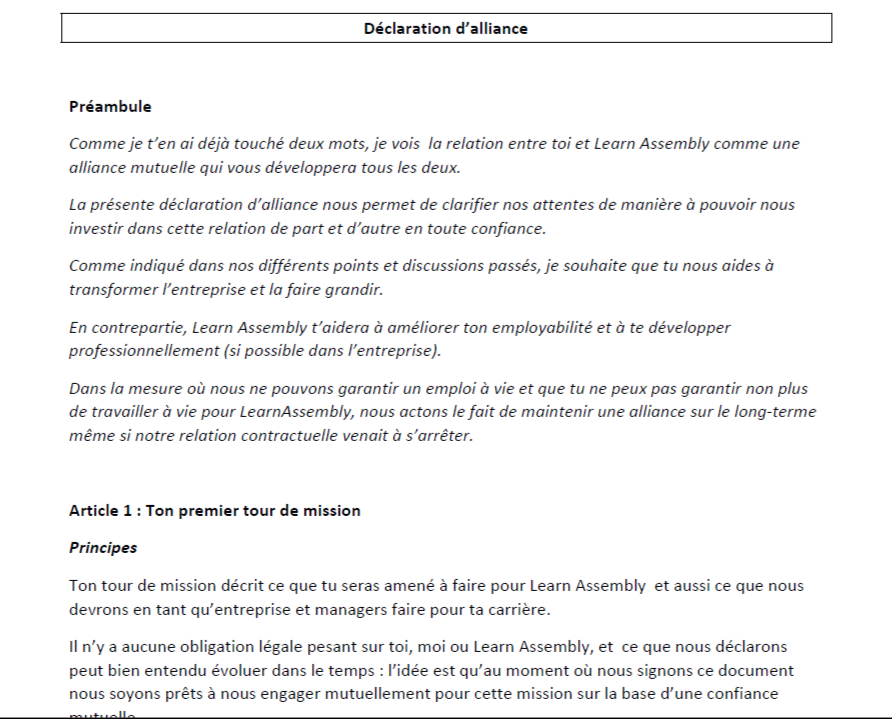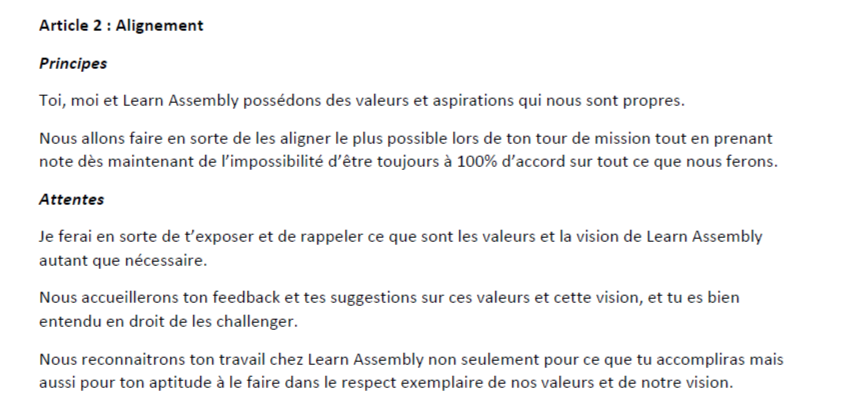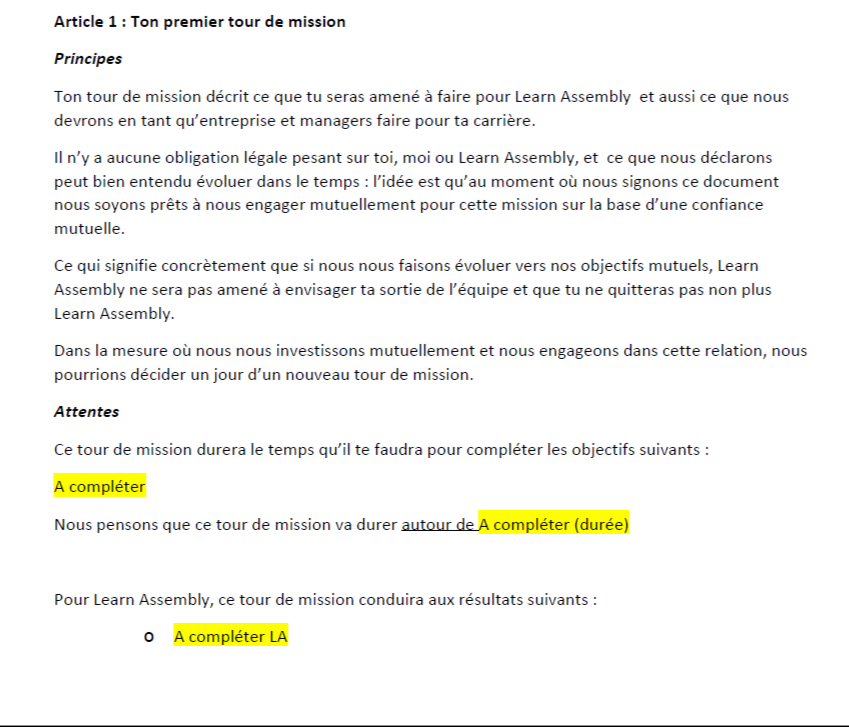Learn Assembly is a growing business that creates learning experiences aimed at developing the employability of their clients, who are employees working for large companies in transformational contexts. While employability is its main concern, Learn Assembly has also made it a pillar of its own internal operations. But how does this company manage to be on the same page as its employees?
It all began in 2017 when Sophie, cofounder of LearnAssembly, finished the book The Alliance, managing talents in the networked age by Reid Hoffman, cofounder of Linkedin. Being an expert in professional networks, Hoffman develops the principle of ‘alliance’. It consists in a new employer-employee pact in which each party agrees to maximize the mutual benefits of collaboration (which is assumed as being limited in time), and to develop one’s employability after leaving the firm. This pact is based on 3 pillars: committing the employees recruited in well-defined ‘tours of duty’, encouraging them to use and develop their professional networks outside the organization, and finally managing a network of committed Alumni who stay close to the company even after their contract ended.
The chief principle underlying it is reciprocity: Both parties understand and acknowledge that they’ve entered into a voluntary relationship that benefits both sides. - Reid Hoffman, Ben Casnocha et Chris Yeh
These concepts, completely aligned with the raison d'être and philosophy of Learn Assembly, hit the nail on the head with Sophie, who suggested to her partner and co-founder to implement them in their team. Indeed, when you consider your coworkers no longer as resources at a given time but as partners during and after contractual collaboration, helping them grow as much as possible and investing in their long-term employability becomes strategic.
This is how Learn Assembly developed its first alliance declarations. It’s a kind of moral commitment made by both parties, usually for ‘tours of duty’ lasting 18 to 24 months. The aim is to objectify the relationship, by clarifying and agreeing together on expectations from both sides right from the beginning. It’s not exactly a job description, nor is it an employment contract or a salary negotiation: it is rather a question of detailing the mission that the person will have to carry out within a defined time horizon, the company's expectations, the way in which this mission enables the coworker to meet his or her objectives, the necessary resources… Not to mention, of course, the employee's expectations and how the company will respond: how will this mission benefit both? What do they want to achieve in the end?

Here’s how it works: Sophie creates a first version on a Word document that she starts filling out with each recruit. The principles and expectations associated with each subject are explained.
For example, you can find:
- The results expected respectively by Learn Assembly and the employee at the end of the tour of duty
- The expectations of operating the professional network for the benefit of the company and the use of dedicated time to develop one’s "personal branding".
- A definition of budget thresholds for personal development costs
- Rules for taking advantage of Learn Assembly's Alumni Group
Learn Assembly will give you time to grow your network, in exchange we expect you to mobilize your network to help us fulfill our mission and make our business successful. - Excerpt from an Alliance statement, Learn Assembly
Newcomers may be a little confused by this way of working at first, but they quickly feel concerned and commit themselves to writing, with their manager by their side, what they think they will achieve, what is expected from them and what they expect from the company. This was also carried out retroactively with the employees already working at Learn Assembly, who wanted to try it out.
 6 months before the end of the tour of duty, the manager and the coworker review together the document and begin considering the next one. They also check the expected results for both parties. This is the best time to consider whether the next round of assignments will take place within Learn Assembly, and if not, how they can help the employee prepare the next step.
6 months before the end of the tour of duty, the manager and the coworker review together the document and begin considering the next one. They also check the expected results for both parties. This is the best time to consider whether the next round of assignments will take place within Learn Assembly, and if not, how they can help the employee prepare the next step.
What’s the use of this document in between two tours of duty? If you think the document stays somewhere at the bottom of a drawer for 12 months, you’ve got the wrong idea. It is used as a guideline a few months after taking office to ensure that expectations are met on both sides, and then at 9, 12 and 18 months. For example, both parties may realize that a gap is widening, either on the Learn Assembly side or on the employee side. In this case a new alliance, closer to reality, can be drafted, or corrective actions can be put in place to get closer to the initial commitments. If this is not enough, a talk will enable both parties to explore all possible options.


It’s important to keep in mind that these alliance declarations remain private, only the co-founders of Learn Assembly and each employee individually have access to the document.
Feedback from Learn Assembly is pretty positive. Sometimes, one’s expectations in the relationship are not met and the statement is used to objectify the situation and anticipate a balanced outcome for both parties. It favors a contract termination by mutual agreement, with no surprises and no hard feelings.
For Sophie, the use of this alliance makes it easier to take up your position. The expected results are explained, detailed on both sides, and written down. The moral contract is clear. From the beginning, everyone acknowledges that cases of separation can happen and that there is no need to be afraid to talk about it, in a framework based on trust. Employees find it reassuring to have a document to hold on to, that is used as a basis for discussion throughout their assignment. This practice makes room for conversation about expectations and ambitions during the collaboration, which is not so common.
This is a positive innovation, but it also shows challenges of its own: starting a new job and talking about a contract termination within the first weeks can be stressful. It’s like anticipating that your ice cream will probably melt on your fingers before you even taste it. Also, it can be scary to think about the relationship with the company beyond the contractual bond and the day it ends.
For now, there is only one level of management at Learn Assembly, so alliance statements are written directly between founders and employees. But seeing how this practice evolves when new managers come in should be interesting.




